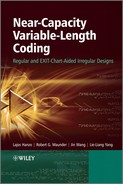Contents
Other Wiley and IEEE Press Books on Related Topics
1.2 Applications of Irregular Variable-Length Coding
1.3 Motivation and Methodology
1.5 Novel Contributions of the Book
Chapter 2: Information Theory Basics
2.1 Issues in Information Theory
2.2 Additive White Gaussian Noise Channel
2.4 Average Information of Discrete Memoryless Sources
2.5 Source Coding for a Discrete Memoryless Source
2.6 Entropy of Discrete Sources Exhibiting Memory
2.9 Run-Length Coding for Discrete Sources Exhibiting Memory
2.10 Information Transmission via Discrete Channels
2.11 Capacity of Discrete Channels [216, 223]
2.12 Shannon’s Channel Coding Theorem [220, 228]
2.13 Capacity of Continuous Channels [217, 223]
2.14 Shannon’s Message for Wireless Channels
Part I: Regular Concatenated Codes and Their Design
Chapter 3: Sources and Source Codes
3.4 Soft Decoding of Variable-Length Codes
Chapter 4: Iterative Source–Channel Decoding
4.1 Concatenated Coding and the Turbo Principle
4.2 SISOAPP Decoders and their EXIT Characteristics
4.3 Iterative Source–Channel Decoding Over AWGN Channels
4.4 Iterative Channel Equalization, Channel Decoding and Source Decoding
Chapter 5: Three-Stage Serially Concatenated Turbo Equalization
5.2 Soft-In Soft-Out MMSE Equalization
5.3 Turbo Equalization Using MAP/MMSE Equalizers
5.4 Three-Stage Serially Concatenated Coding and MMSE Equalization
5.5 Approaching the Channel Capacity Using EXIT-Chart Matching and IRCCs
5.6 Rate Optimization of Serially Concatenated Codes
5.7 Joint Source-Channel Turbo Equalization Revisited
Part II: Irregular Concatenated VLCs and Their Design
Chapter 6: Irregular Variable-Length Codes for Joint Source and Channel Coding
6.2 Over view of Proposed Scheme
6.3 Transmission Frame Structure
6.5 APP SISO VDVQ/RVLC Decoding
Chapter 7: Irregular Variable-Length Codes for EXIT-Chart Matching
7.2 Overview of Proposed Schemes
7.3 Parameter Design for the Proposed Schemes
Chapter 8: Genetic Algorithm-Aided Design of Irregular Variable-Length Coding Components
8.3 Overview of the Proposed Genetic Algorithm
8.4 Overview of Proposed Scheme
8.5 Parameter Design for the Proposed Scheme
9.2 Modifications of the EXIT-Chart Matching Algorithm
9.4 Overview of the Transmission Scheme Considered
Part III: Applications of VLCs
10.2 Space–Time Coding Overview
10.3 Two-Dimensional VLC Design
Chapter 11: Iterative Detection of Three-Stage Concatenated IrVLC FFH-MFSK
11.4 System Parameter Design and Results
Chapter 12: Conclusions and Future Research
12.2 Chapter2:Information Theory Basics
12.3 Chapter3: Sources and Source Codes
12.4 Chapter4: Iterative Source–Channel Decoding
12.5 Chapter5: Three-Stage Serially Concatenated Turbo Equalization
12.6 Chapter 6: Joint Source and Channel Coding
12.7 Chapters 7–9: EXIT-Chart Matching
12.8 Chapter 8: GA-Aided Design of Irregular VLC Components
12.9 Chapter 9: Joint EXIT-Chart Matching of IRVLCs and IRURCs
12.10 Chapter 10: Iteratively Decoded VLC Space–Time Coded Modulation
12.11 Chapter 11: Iterative Detection of Three-Stage Concatenated IrVLCFFH-MFSK
Appendix A VLC Construction Algorithms
A.1 First RVLC Construction Algorithm
A.2 Second RVLC Construction Algorithm
A.3 Greedy Algorithm and Majority Voting Algorithm (MVA)
